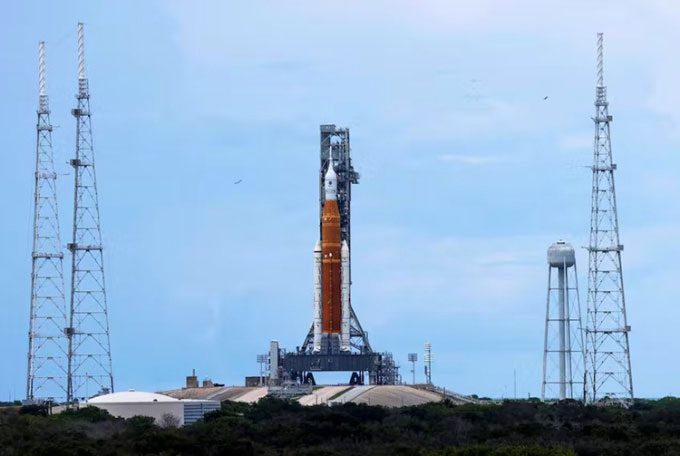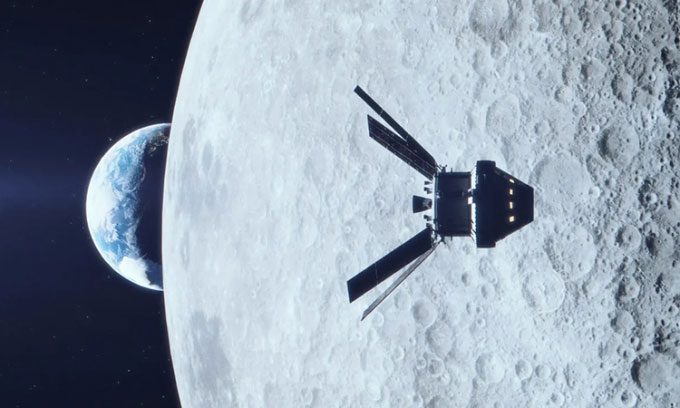The first flight in the Artemis Moon exploration program will include a series of scientific experiments to prepare for future missions.

SLS rocket and Orion spacecraft on the launch pad in Florida on August 29. (Photo: Reuters)
If the second launch opportunity goes smoothly, the Space Launch System (SLS) rocket will send the Orion spacecraft into lunar orbit from Kennedy Space Center in Florida, USA, on September 2.
Artemis 1 is the first mission in the Artemis Moon exploration program, as well as the first flight of the SLS. The primary goal of the mission is to demonstrate that both vehicles are ready to begin launching astronauts to the Moon and other deep space destinations.
This six-week test flight will not carry a crew; instead, it will transport three high-tech crash test dummies named Zohar, Helga, and Moonikin Campos, equipped with a range of sensors to measure everything from vibrations to radiation.
In addition to the dummies, the Orion spacecraft will carry various scientific payloads, including seeds, algae, fungi, and yeast, carefully packed to study how space radiation affects the life of DNA-based cells. The ultimate goal is to help humanity settle on planets beyond Earth, such as Mars.
Through industry partnerships, the mission will also include a laptop running both the Alexa virtual assistant and Cisco Webex conferencing software to see how well it communicates with the ground station in Houston, Texas.
Artemis 1 will also deploy several shoe box-sized satellites – known as CubeSats – to study the Moon’s surface and analyze its composition.
However, the highest priority test is the new heat shield on Orion to protect the spacecraft as it re-enters the atmosphere at record speeds, faster than the Space Shuttle. This could cause the spacecraft to heat up to 2,760 degrees Celsius.
“This is no longer the Apollo generation; it is the Artemis generation. We will return to the Moon but will learn and develop new technologies, because the ultimate goal is to head to Mars,” emphasized NASA Administrator Bill Nelson.

Simulation of the Orion spacecraft orbiting the Moon during the Artemis 1 mission. (Photo: NASA)
Last year, NASA landed a truck-sized rover on Mars, deployed a mini helicopter in the thin atmosphere of the planet, and recently received the first images from the James Webb Space Telescope.
This reflects the technological and scientific momentum that Artemis aims to harness, following the failure of NASA’s crewed Constellation spaceflight program from 2005 to 2009. Former U.S. President Barack Obama initiated the Artemis program in 2010, setting 2033 as the target year for humans to conquer Mars.
There is still much to learn about the Moon. Thomas Zurbuchen, head of NASA’s Science Mission Directorate, recalls a favorite photo of Buzz Aldrin conducting a scientific experiment on the Moon’s surface in 1969: deploying a piece of aluminum foil to collect solar wind shining on the Moon’s surface at a speed of 400 km/s. It is a perfect example of an astronaut as a scientist.
One important mission of Artemis 1 is to investigate natural resources, such as water or minerals, that may be present on the Moon. “Of course, those resources must really surprise us compared to the picture of the Moon we had in the past,” Zurbuchen said.
For example, water has been discovered on the Moon, and two of the CubeSats on board will map that water in different ways: one using neutrons and another using infrared spectroscopy.
Another CubeSat, named NEA Scout, will deploy “solar sails” spanning 86 m2 within two years, targeting a near-Earth asteroid, after which it will photograph and analyze the shape, mass, rotation characteristics, debris, dust, and surface appearance.
Artemis 1 is the first mission in the Artemis Moon exploration program since the last Apollo mission in 1972. After nearly 50 years, NASA has established a program aimed at landing humans in unexplored areas of the Moon.
According to the timeline, after the successful launch of Artemis 1, this uncrewed mission will test all new components that will make future deep space exploration feasible. Subsequently, astronauts are set to embark on their journey in 2024 and 2025 during the Artemis II and Artemis III missions.

















































